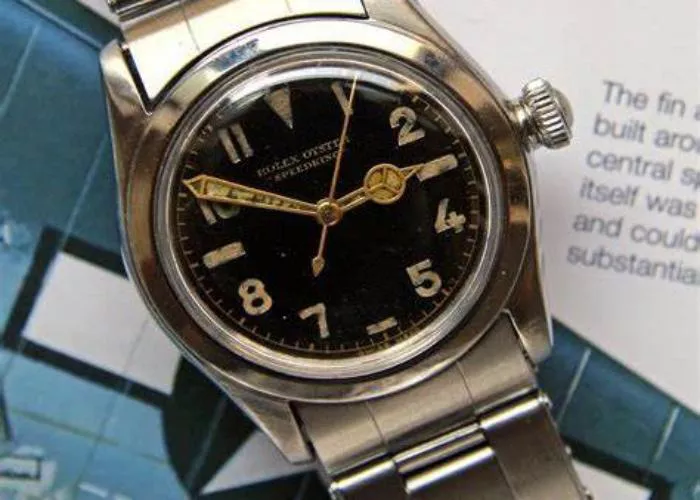For nearly three decades, the Rolex Speedking stood as the most accessible men’s watch in the Rolex lineup. Produced from approximately 1941 to 1970, this no-frills timepiece featured a manual-wind movement and a modest 30mm case—compact by today’s standards but a staple of its era. Built with Rolex’s signature waterproof Oyster case and screw-down crown, the Speedking was primarily offered in stainless steel and was among the first models to introduce the now-iconic Mercedes hands.
Origins and Early History
While some claim the Speedking debuted around 1935—coinciding with Rolex ambassador Malcolm Campbell’s land speed record achievement—concrete evidence suggests production began in earnest in the 1940s. Early references, such as the 2280 and 4220, solidified the Speedking’s place in Rolex’s catalog.
Initially, Rolex’s entry-level offerings included names like “Oyster Royal,” “Royalite,” and other short-lived variants. By the late 1940s, the Speedking emerged as the smallest men’s model at 30mm, while the Royal expanded to 32mm. Other obscure names, such as “Firefly” and “Drake,” were phased out, leaving the Speedking as a distinct and enduring option.
Design Evolution: From California Dials to Modern Updates
Early Speedkings featured distinctive design elements, including blued Mercedes hands and California dials—a patented “Error-Proof Dial” style with half-Roman numerals. These watches often used radium-based lume, a feature collectors should approach with caution due to its radioactive properties.
By the 1950s, alpha hands replaced Mercedes hands, and California dials were discontinued. The post-war era saw a shift toward simpler stick markers. The Speedking’s design remained largely consistent, though subtle updates included the introduction of the Oyster bracelet in 1948 and movement enhancements, such as the Caliber 1220’s increased beat rate in the 1960s.
Rare Variations and Collectibility
Most Speedkings were stainless steel, but rare solid gold versions—such as the 6420—and gold-plated references like the 6418 occasionally surface. Dial colors were predominantly silver, though black and champagne variants exist, with minor variations due to multiple suppliers.
Despite its quarter-century presence, the Speedking never appeared in Rolex advertisements, adding to its understated charm. Today, it remains a sought-after piece for collectors seeking an affordable yet historically significant vintage Rolex.
Related topics:
- What is a Rolex Azzurro Blue Datejust?
- All About the Rolex Sky-Dweller
- Rolex 2025 Price Increases: Another Hike in Effect as of May


